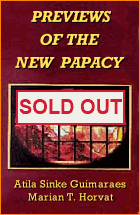Art & Architecture
 |
 |
 |
 |
 |
 |
 |
The Dark World of Art at the Biennale
To send light into the darkness of men's hearts – this used to be art's purpose. Anyone visiting the 2015 Venice Biennale, however, will find the exact opposite to be true. The 140 artists and groups featured at it take the viewers straight into the heart of darkness and despair.
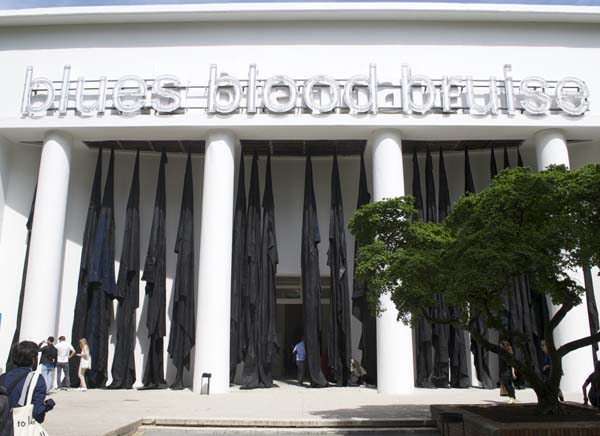
The first sight of the Giardini [= gardens] in Venice that houses the central exhibition sets the tone for the event: Dark black drapery hangs at the front façade below a tall neon sign that reads “blues blood bruise,” above. Yes, the drapery and mural are both “art works” by Oscar Murillo and Glen Ligon, who intend to chasten viewers right from the beginning for their role in destroying ecology and engaging in Capitalism and war.
The Biennale's central exhibition, titled “All the World's Futures,” is curated by Nigerian Okwui Enwezor, director of the Haus der Kunst in Munich. His stated purpose is to focus on social inequalities and the heavy psychological, economic and physical tolls exacted by global Capitalism.
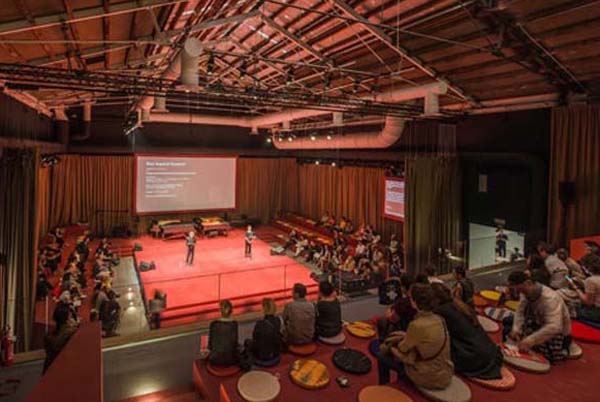 So, you enter the Giardini into a room of drawings that scream in block letters THE END and FINE. The end of what? Life? The world? Oppression? Who knows? Off in the corner, one is invited to see a short film that shows a man sitting against a wall vomiting blood. Then, on to the Arena, above, where a full reading of Marx's Das Kapital will take place as an “art event” for the whole seven months of the Exhibition, running from May 9 to November 22, 2015.
So, you enter the Giardini into a room of drawings that scream in block letters THE END and FINE. The end of what? Life? The world? Oppression? Who knows? Off in the corner, one is invited to see a short film that shows a man sitting against a wall vomiting blood. Then, on to the Arena, above, where a full reading of Marx's Das Kapital will take place as an “art event” for the whole seven months of the Exhibition, running from May 9 to November 22, 2015.
Let us take a look at some of the pavilions that have received special acclaim from the art world and media.
The occult
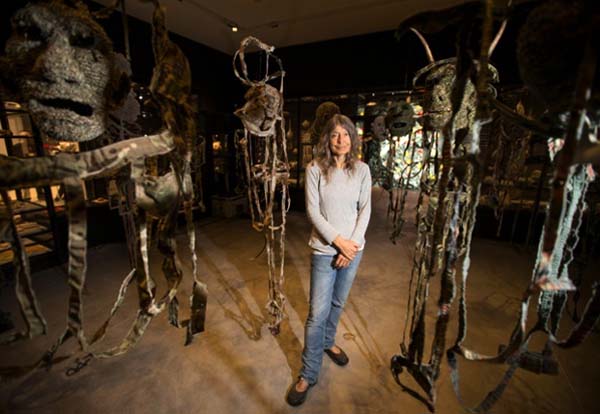 It looks like the lair of a voodoo priestess with its shrunken heads and spirit masks. The Australian Pavilion has been one of the most popular since its opening. The artist Fiona Hall,
above, filled her space with the “indigenous voice” - the shaman world of demons.
It looks like the lair of a voodoo priestess with its shrunken heads and spirit masks. The Australian Pavilion has been one of the most popular since its opening. The artist Fiona Hall,
above, filled her space with the “indigenous voice” - the shaman world of demons.
It is a dark celebration of the occult, the Devil crying victory over the art and beauty of Christian Civilization. To give prestige to this vision of the world, Australian Attorney General George Brandis and actress Cate Blanchett were there for the opening day giving speeches of praise.
Obscenities
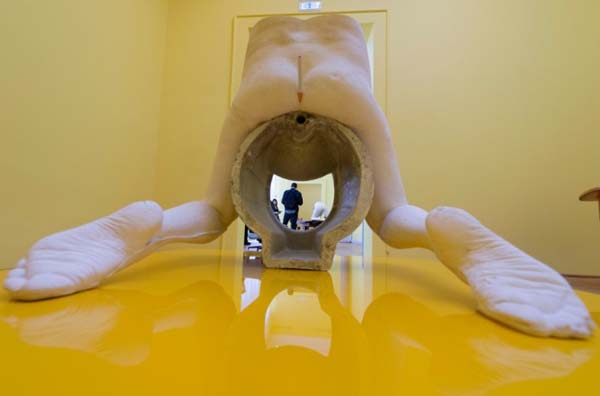
The custard-yellow rooms of Sarah Lucas in the British Pavilion are filled with nude porn dollies, which, keeping with her style, exhibit only their lower halves. There is “Edith stooped over a toilet seat,” “Margot draped on a fridge” and “Sarah bent over a bar.” How could the wholly irreverent Lucas represent Great Britain at this international art world event?
She displays her obscene figures, including a 3-meter tall yellow penis and a huge naked fanny that sits over a life size tunnel, above, in an exhibit that has received 4 star reviews. “No one's told me off about the fannies yet,” Lucas boasts. I think it's high time someone did...
Anti-intellectualism
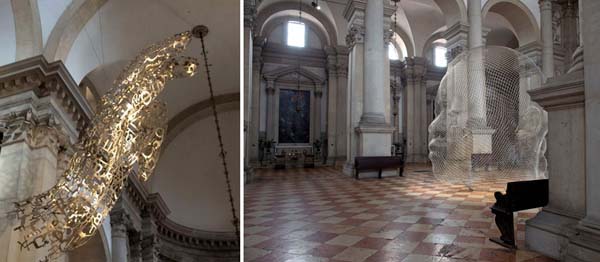
An enormous wire mesh head of a young girl in the central aisle of the Abbey of San Giorgio Maggiore, above right, faces a suspended steel hand floating in the nave, left. The filigree made up of letters from eight alphabets is an ecumenical symbol meant “to anoint its visitors from all religions,” explains Spanish artist Jaume Plensa. The pieces are titled “Together” and represent an intuitive spiritual discourse.
What does this mean? The viewer is not supposed to ask this question. He must just “experience the art.” It is “a return to beauty without intellectualism,” says Plensa. Breaking down the barriers of Western Civilization is what Plensa does as an artist. It is a rejection of reason, which makes man the image of Christ.
Goddess Mother Earth
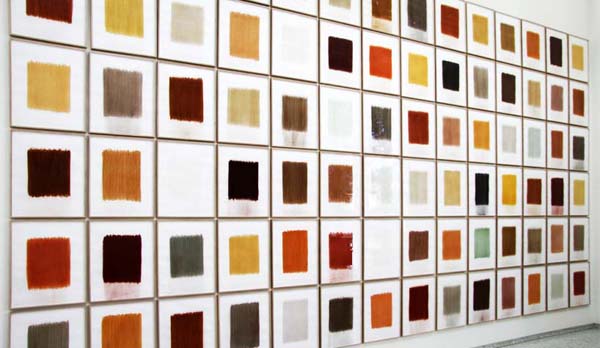
This patchwork of colors, above, is the work of Herman de Vires at the Dutch pavilion. It’s title is “Zen - To be all ways to be.” What is it? A show of samples of soil from different locations all over the world framed on paper sheets. Each rubbing is created by the minimal swipe of the artist's hand. His aim is to “transmit an increased awareness of what nature presents and what is our primary reality.”
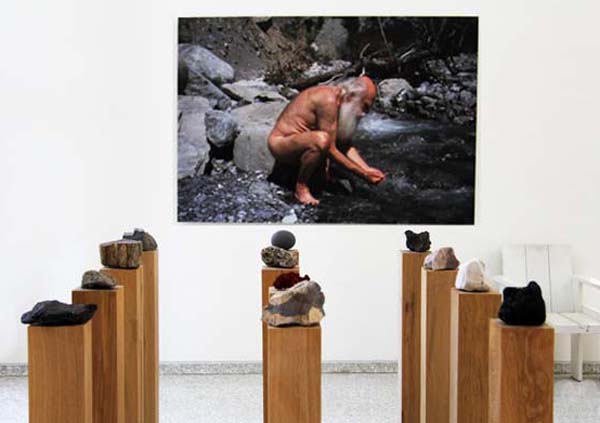
He also displays a collection of “raw stones” denoting 12 fragments of reality, above. No artistic genius here, just a collection of stones on tall wooden plinths. Behind them we are treated to a photograph of the nude artist, de Vries, drinking from the stream, a “metaphor of life” or “a symbol of the great process in which we are participating.”
The viewer is supposed to study this ensemble without questioning what it looks like, an attitude toward nature that has roots in Taosim and Zen Buddhism, which has long influenced de Vries.
The bizarre
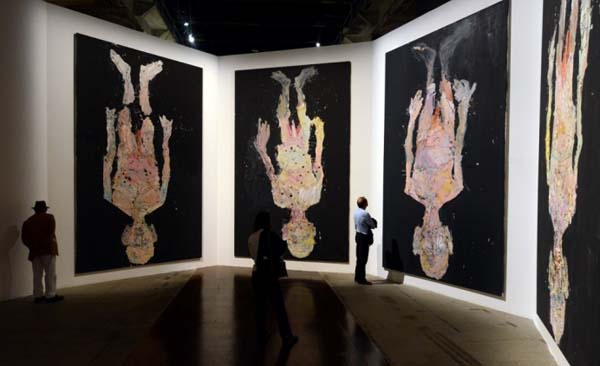
Turning art on its head is the credo of 77-year-old painter and sculptor Georg Baselitz, who for years has been showing his work upside down. And so we find these strange naked ET figures in the German pavilion, above. Baselitz says the figures are self-portraits that express his war time experiences as a young man.
The anti-war message was all-prevailing at the Biennale, and here is a prime example of the message wrapped in the bizarre.
Evolutionism & absurdity
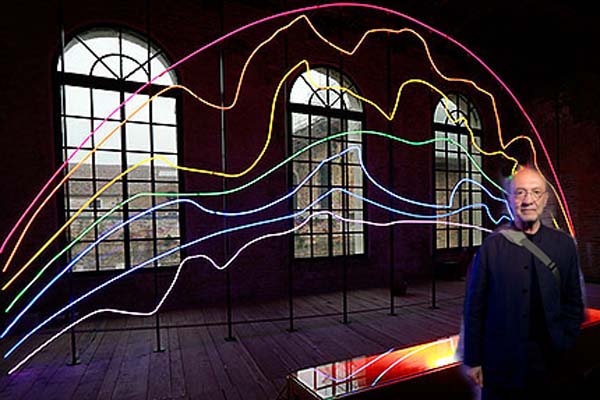
Everywhere we find reference to the supposed evolutionist process of nature and, of course, man's guilt by violating it. Representing Turkey with an exhibition entitled “Respiro,” conceptual artist Sarkis, above, presents this neon show that is supposed to represent “a more expansive context of a million plus years, going back to the creation of the universe and the beginning of time, back to the first-ever rainbow – the very first magical breaking point of light.” Since the homosexuals have usurped the rainbow symbol, this imagery pleases that group, as it was intended to do, no doubt.
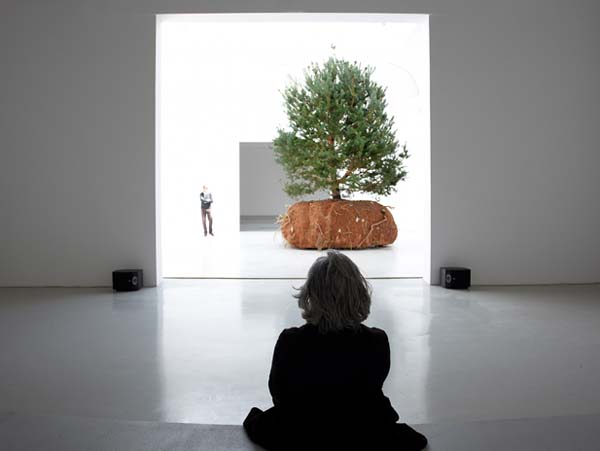
France's pavilion by Céleste Boursier-Bougenot, above, is also an extravagant minimalist presentation of nature. An uprooted tree electronically wired to rustle sits in the middle of the pavilion room. That's it. Visitors are invited to sit and meditate. It's absurd. But this is art at the Biennale.
'The Word became flesh'
Because of its bizarre and often immoral modern art, these expositions of the Biennale were condemned by the Church before Vatican II. Today, however, the Vatican is one of the exhibitors. For the second time the Church has a pavilion with a supposed sacred theme that is again woefully bereft of any sacral content. Rather, it faithfully follows the Francis line of condemning Capitalism, promoting evolution and exalting the marginalized.
The theme of the Vatican pavilion is “In the Beginning… the Word became flesh,” but there is nothing to remind one of Our Lord Jesus Christ. None of the three artists commissioned by Card. Gianfranco Ravasi, President of the Pontifical Council for Culture, are practicing Catholics. Not a matter of concern to the Prelate, who was proudly present at the opening. There is no truth in the modern art world, no beginning or end.
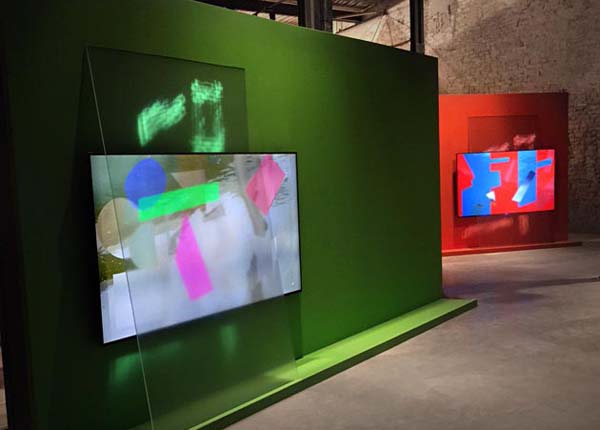
The title of Monika Bravo's contribution – “The sound of the word is beyond sense” – says it all. The Word is senseless, irrational. Her “narrative,” above, is composed of erratic shape, forms and colors on live screens and transparent panels. She calls them archetypes and asks whether the world we live in is nothing but a mental construct. This is a new type of meditation that has nothing Catholic about it.
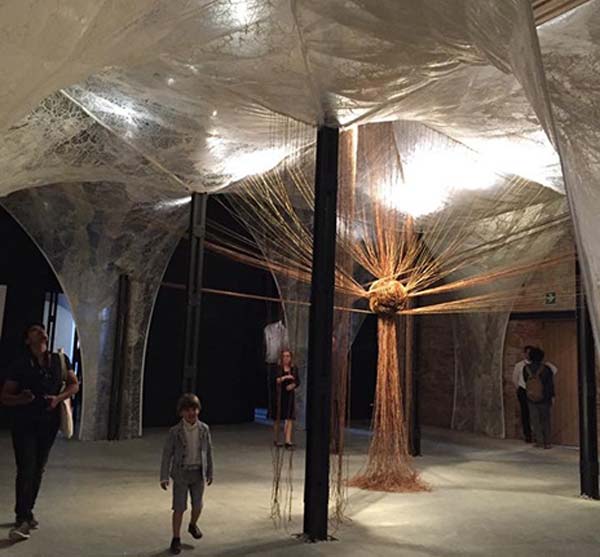
It only gets worse. The young Macedonian Elpida Hadzi-Vasileva’s contribution to the Vatican Pavilion, above, is a kind of tent made of organic waste materials including animal intestines and hides, above. It is a “symbol” that reflects how "a second skin gives way to beauty." A distorted notion of beauty, certainly.
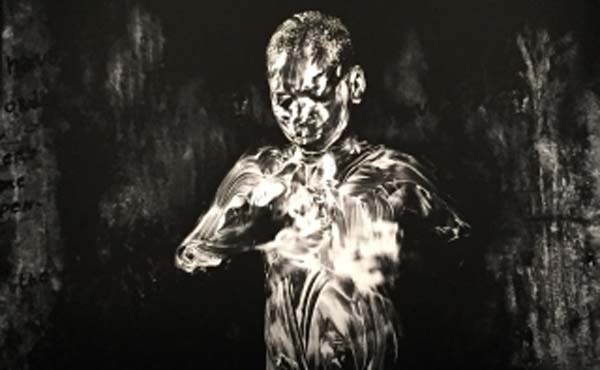
Finally, the third exhibit in the Vatican Pavilion by 30-year-old Mário Macilau of Mozambique displays photographs, like the one above, documenting the lives of street children in his country’s capital. This is a social-political statement perhaps, but can it be considered art?
One exhibition after another... the oppression of man by Capitalism, the destruction of nature by man, the horror of war. “Hectoring and joyless,” one reviewer called it. “Bleak and ominous,” said another. Pantheist, communist and at times even Satanist, I add. This is the modern world of art that the Vatican has blessed and embraced.
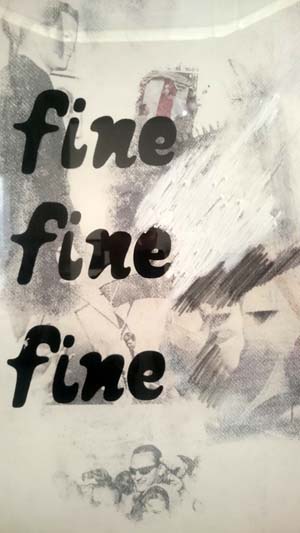


The first sight of the Giardini [= gardens] in Venice that houses the central exhibition sets the tone for the event: Dark black drapery hangs at the front façade below a tall neon sign that reads “blues blood bruise,” above. Yes, the drapery and mural are both “art works” by Oscar Murillo and Glen Ligon, who intend to chasten viewers right from the beginning for their role in destroying ecology and engaging in Capitalism and war.
The Biennale's central exhibition, titled “All the World's Futures,” is curated by Nigerian Okwui Enwezor, director of the Haus der Kunst in Munich. His stated purpose is to focus on social inequalities and the heavy psychological, economic and physical tolls exacted by global Capitalism.

An ongoing reading of Marx' Das Kapital - an “art event” at the Venice Biennale
Let us take a look at some of the pavilions that have received special acclaim from the art world and media.
The occult

A voodoo-like display of heads supposedly representing Creation
It is a dark celebration of the occult, the Devil crying victory over the art and beauty of Christian Civilization. To give prestige to this vision of the world, Australian Attorney General George Brandis and actress Cate Blanchett were there for the opening day giving speeches of praise.
Obscenities

The custard-yellow rooms of Sarah Lucas in the British Pavilion are filled with nude porn dollies, which, keeping with her style, exhibit only their lower halves. There is “Edith stooped over a toilet seat,” “Margot draped on a fridge” and “Sarah bent over a bar.” How could the wholly irreverent Lucas represent Great Britain at this international art world event?
She displays her obscene figures, including a 3-meter tall yellow penis and a huge naked fanny that sits over a life size tunnel, above, in an exhibit that has received 4 star reviews. “No one's told me off about the fannies yet,” Lucas boasts. I think it's high time someone did...
Anti-intellectualism

An enormous wire mesh head of a young girl in the central aisle of the Abbey of San Giorgio Maggiore, above right, faces a suspended steel hand floating in the nave, left. The filigree made up of letters from eight alphabets is an ecumenical symbol meant “to anoint its visitors from all religions,” explains Spanish artist Jaume Plensa. The pieces are titled “Together” and represent an intuitive spiritual discourse.
What does this mean? The viewer is not supposed to ask this question. He must just “experience the art.” It is “a return to beauty without intellectualism,” says Plensa. Breaking down the barriers of Western Civilization is what Plensa does as an artist. It is a rejection of reason, which makes man the image of Christ.
Goddess Mother Earth

This patchwork of colors, above, is the work of Herman de Vires at the Dutch pavilion. It’s title is “Zen - To be all ways to be.” What is it? A show of samples of soil from different locations all over the world framed on paper sheets. Each rubbing is created by the minimal swipe of the artist's hand. His aim is to “transmit an increased awareness of what nature presents and what is our primary reality.”

He also displays a collection of “raw stones” denoting 12 fragments of reality, above. No artistic genius here, just a collection of stones on tall wooden plinths. Behind them we are treated to a photograph of the nude artist, de Vries, drinking from the stream, a “metaphor of life” or “a symbol of the great process in which we are participating.”
The viewer is supposed to study this ensemble without questioning what it looks like, an attitude toward nature that has roots in Taosim and Zen Buddhism, which has long influenced de Vries.
The bizarre

Turning art on its head is the credo of 77-year-old painter and sculptor Georg Baselitz, who for years has been showing his work upside down. And so we find these strange naked ET figures in the German pavilion, above. Baselitz says the figures are self-portraits that express his war time experiences as a young man.
The anti-war message was all-prevailing at the Biennale, and here is a prime example of the message wrapped in the bizarre.
Evolutionism & absurdity

Everywhere we find reference to the supposed evolutionist process of nature and, of course, man's guilt by violating it. Representing Turkey with an exhibition entitled “Respiro,” conceptual artist Sarkis, above, presents this neon show that is supposed to represent “a more expansive context of a million plus years, going back to the creation of the universe and the beginning of time, back to the first-ever rainbow – the very first magical breaking point of light.” Since the homosexuals have usurped the rainbow symbol, this imagery pleases that group, as it was intended to do, no doubt.

France's pavilion by Céleste Boursier-Bougenot, above, is also an extravagant minimalist presentation of nature. An uprooted tree electronically wired to rustle sits in the middle of the pavilion room. That's it. Visitors are invited to sit and meditate. It's absurd. But this is art at the Biennale.
'The Word became flesh'
Because of its bizarre and often immoral modern art, these expositions of the Biennale were condemned by the Church before Vatican II. Today, however, the Vatican is one of the exhibitors. For the second time the Church has a pavilion with a supposed sacred theme that is again woefully bereft of any sacral content. Rather, it faithfully follows the Francis line of condemning Capitalism, promoting evolution and exalting the marginalized.
The theme of the Vatican pavilion is “In the Beginning… the Word became flesh,” but there is nothing to remind one of Our Lord Jesus Christ. None of the three artists commissioned by Card. Gianfranco Ravasi, President of the Pontifical Council for Culture, are practicing Catholics. Not a matter of concern to the Prelate, who was proudly present at the opening. There is no truth in the modern art world, no beginning or end.

The title of Monika Bravo's contribution – “The sound of the word is beyond sense” – says it all. The Word is senseless, irrational. Her “narrative,” above, is composed of erratic shape, forms and colors on live screens and transparent panels. She calls them archetypes and asks whether the world we live in is nothing but a mental construct. This is a new type of meditation that has nothing Catholic about it.

It only gets worse. The young Macedonian Elpida Hadzi-Vasileva’s contribution to the Vatican Pavilion, above, is a kind of tent made of organic waste materials including animal intestines and hides, above. It is a “symbol” that reflects how "a second skin gives way to beauty." A distorted notion of beauty, certainly.

Finally, the third exhibit in the Vatican Pavilion by 30-year-old Mário Macilau of Mozambique displays photographs, like the one above, documenting the lives of street children in his country’s capital. This is a social-political statement perhaps, but can it be considered art?
One exhibition after another... the oppression of man by Capitalism, the destruction of nature by man, the horror of war. “Hectoring and joyless,” one reviewer called it. “Bleak and ominous,” said another. Pantheist, communist and at times even Satanist, I add. This is the modern world of art that the Vatican has blessed and embraced.

Another Biennale art work...

Posted June 24, 2015
______________________
______________________











